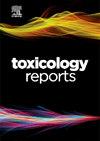Multi-endpoint assessment of tunnel wash water and tyre-particle leachate in zebrafish larvae
Q1 Environmental Science
引用次数: 0
Abstract
Washing of road tunnels is essential for removing accumulated pollutants such as tyre wear particles, brake dust, exhaust residues, and road debris to ensure visibility and safe driving. Tunnel washing generates large volumes of contaminated runoff known as untreated tunnel wash runoff (UTWR). Some countries filter UTWR through a sedimentation process before release to reduce contamination, generating what is known as treated tunnel wash runoff (TWR). This study investigates the potential environmental impact of diluted UTWR (25 %) and TWR (50 %) by evaluating their toxicity in fish and comparing the effect to tyre-particle leachate (TPL, 2 g/L). UTWR was collected during tunnel cleaning, and TWR was collected after 14 days of filtration through sand sediments, from the Bodø tunnel in Norway. Zebrafish larvae, used as a fish model, exposed to contaminated runoff exhibited increased mortality, impaired growth, developmental anomalies, altered swimming behaviour, and changes in gene expression. Both UTWR and TWR exposure induced significant toxicity in zebrafish larvae, though the toxicity caused by TWR was notably lower than that of UTWR. This study shows that current filtration methods of tunnel wash water reduce the levels of most pollutants, however, more research is needed on how tunnel wash-water runoff affect aquatic ecosystems.
斑马鱼幼虫体内隧道冲洗水和轮胎颗粒渗滤液的多终点评价
清洗道路隧道对于清除累积的污染物(如轮胎磨损颗粒、刹车灰尘、尾气残留物和道路碎片)至关重要,以确保能见度和安全驾驶。隧道冲刷产生大量被污染的径流,即未经处理的隧道冲刷径流(UTWR)。一些国家通过沉淀过程过滤UTWR,然后再释放,以减少污染,产生所谓的处理隧道冲刷径流(TWR)。本研究通过评估稀释UTWR(25 %)和TWR(50 %)对鱼类的毒性,并将其与轮胎颗粒渗滤液(TPL, 2 g/L)的影响进行比较,探讨了稀释UTWR(25 %)和TWR(50 %)对环境的潜在影响。UTWR是在隧道清洗过程中收集的,在挪威Bodø隧道的沉积物中过滤14天后收集TWR。作为鱼类模型的斑马鱼幼虫暴露于受污染的径流中,表现出死亡率增加、生长受损、发育异常、游泳行为改变和基因表达变化。UTWR和TWR暴露对斑马鱼幼虫均有显著的毒性作用,但TWR的毒性作用明显低于UTWR。本研究表明,目前隧道冲刷水的过滤方法降低了大多数污染物的水平,然而,隧道冲刷水径流如何影响水生生态系统还需要更多的研究。
本文章由计算机程序翻译,如有差异,请以英文原文为准。
求助全文
约1分钟内获得全文
求助全文
来源期刊

Toxicology Reports
Environmental Science-Health, Toxicology and Mutagenesis
CiteScore
7.60
自引率
0.00%
发文量
228
审稿时长
11 weeks
 求助内容:
求助内容: 应助结果提醒方式:
应助结果提醒方式:


